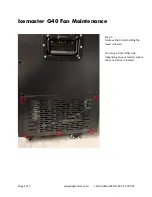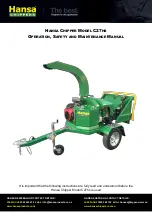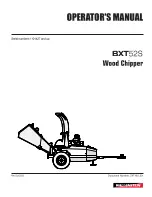
9
BXTR6438
2.4.3 Be Prepared
•
Wear appropriate personal protective equipment. Tie back
long hair, remove jewelry, and avoid loose fitting clothing.
Prolonged exposure to loud noise can cause permanent
hearing loss! Wear hearing protection on a full-time basis
when using this machine.
•
Keep bystanders at safe distance at least 20 ft (6 m) from
work zone. Mark the zone with safety cones.
•
Determine where chips are piled and ensure the location
does not interfere with safe operation of the machine.
•
Determine a safe work area location:
-
area must be clear of stones, branches or hidden
obstacles that might cause a tripping, hooking, or
snagging hazard
-
ground should be firm and level
•
Be aware of overhead hazards such as branches, cables, or
electrical wires.
•
Operate only in daylight or good artificial light.
•
Make sure machine is properly adjusted and in good
operating condition.
•
Store fuel well away from the material pile.
2.4.4 Operating Safety
Read and obey the safety signs on the machine. Clean or
replace them if they are not legible.
There is no substitute for a cautious, safe-minded operator
who recognizes potential hazards and follows reasonable
safety practices. This machine must be used with all its
safety equipment properly installed to minimize the chance of
accidents.
•
When operating this equipment always have at least
two workers present and trained in safe operation of the
machine.
•
The operator must always be in control of the machine.
The spotter must remain out of the danger zone while the
machine is in operation. Bystanders must remain in the
safe zone.
•
Do not overreach into the hopper. Always keep proper
balance and footing.
•
Feed rollers can cause serious injury or death. Keep hands,
feet, and clothing away from the feed roller.
•
Never allow anyone to sit on the feed table.
•
Do not put metal objects, bottles, cans, rocks, glass,
or other foreign material into wood chipper. If such
items happen to get into the chipper, stop machine and
turn engine off. Wait for all moving parts to stop before
removing material. Inspect machine for damaged or loose
parts before resuming work.
•
Make sure all guards, deflectors and shields are in place
before starting and operating.
•
Do not allow anyone within the work or danger zone during
operation. Ejected wood chips can cause injuries. Keep
children away.
•
Never place any part of your body where it would be
in danger if machine movement should occur during
assembly, installation, operation, maintenance, repairing,
unplugging, or moving.
•
Inspect electrical harness, sensors, and con troller to make
sure they are in good condition before operating.
•
Do not operate on hillsides or when working area is
cluttered, wet, muddy, or icy to prevent slipping and
tripping. Operate only on level ground.
•
Position machine so prevailing winds blow engine exhaust
fumes away from operator's station.
•
Never use engine-powered machinery indoors. Gas engine
exhaust contains toxic carbon monoxide, which cannot be
smelled or seen. Breathing carbon monoxide can be lethal.
•
Stop engine when leaving the machine unattended.
2.5 Equipment Safety Guidelines
•
Never use equipment with safety shields removed. Keep all
shields in place. If shield removal becomes necessary for
repairs, reinstall the shield prior to use.
•
Do not allow anyone other than a responsible, properly
trained and physically able person to operate this machine.
This equipment is dangerous to children and persons
unfamiliar with its operation.
•
Do not modify the equipment in any way. Unauthorized
modification may result in serious injury or death and may
impair the function and life of the equipment.
•
Never exceed the limits of the machine. If its ability to do
the job or to do it safely is in question—
STOP IMMEDIATELY!
2.5.1 Transport Safety
•
Comply with local laws governing safety and transporting
of machinery on public roads.
•
Do not exceed 50 mph (80 km/h) when towing this
machine. Slow down for rough terrain and cornering.
•
Do not transport or move the wood chipper with the engine
running.
•
Ensure all latch handles are secure.
•
Be sure the trailer is hitched correctly to the towing vehicle
and a retainer is used through the hitch mechanism.
•
Always attach safety chains between the hitch and the
towing vehicle. Cross the chains underneath the trailer
tongue.










































